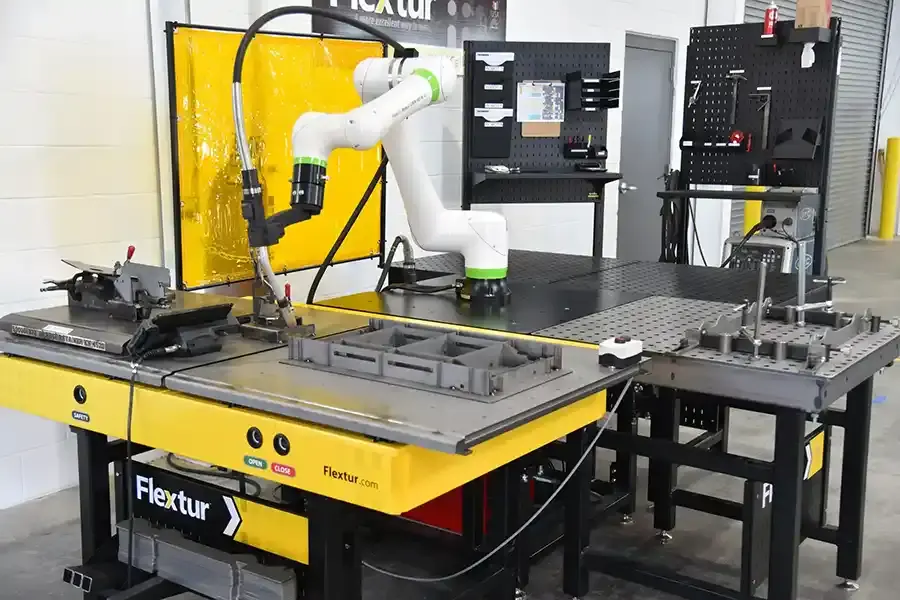Ensuring COBOT Safety in the Era of Collaborative Welding Robots

The Importance of Cobot Safety Shouldn't Be Undermined
The rise of collaborative robots, or cobots, has transformed the manufacturing landscape, particularly in welding applications, enabling humans and robots to work side by side. Unlike traditional industrial robots, which operate in isolation from human workers, welding cobots are designed to interact safely with people. This paradigm shift brings tremendous productivity gains and underscores the critical importance of ensuring cobot safety in welding environments.
The significance of cobot safety in welding can't be overstated. First and foremost, the ability of cobots to work in close proximity to human workers necessitates robust safety measures to prevent accidents and injuries. Welding involves high temperatures, intense light, and hazardous fumes, making safety a paramount concern, and ensuring safety is not only a legal and ethical obligation but also essential for maintaining workforce morale and trust in automation technology.
Moreover, safe working environments lead to higher productivity. Workers who feel secure working alongside welding cobots can focus on their tasks without apprehension. This harmonious human-robot collaboration can lead to significant efficiency gains and reduced downtime.
Furthermore, adhering to safety standards and regulations is mandatory. Organizations must comply with standards such as ISO 10218-1 and ISO/TS 15066, which provide guidelines for the safe design and use of cobots in welding. Non-compliance can result in legal repercussions and financial penalties.
Key Safety Features
To ensure cobot safety in welding, several key technologies play a crucial role. Modern welding cobots are equipped with advanced force and torque sensors that detect the amount of force being applied. These sensors enable cobots to react in real-time to unexpected interactions, reducing the risk of injury. For example, if a cobot senses an unusual force while welding, it can stop immediately to prevent harm. This reliance on advanced technologies provides a strong safety net, reassuring workers about the safety measures in place.
In addition to force and torque sensing, vision systems, including cameras and LIDAR, allow welding cobots to perceive their environment. These systems can detect the presence of humans and other obstacles, enabling the cobot to navigate around them safely. Vision technology supports tasks like seam tracking and quality inspection, enhancing safety and functionality.
Another critical safety feature in cobot welding is the safety-rated monitored stop, which ensures that a cobot can stop operating when a human enters its workspace. Using sensors to monitor the area, the cobot triggers an immediate halt to its movement, ensuring that human workers can safely interact with it when needed. Furthermore, welding cobots can adjust their speed based on the proximity of human workers. When a human approaches, the cobot slows down or stops altogether. This dynamic adjustment ensures that the cobot operates at a safe speed when near humans, minimizing the risk of accidents.
Power and force limiting is another intrinsic safety feature that limits the power and force a welding cobot can exert. Even if a cobot contacts a human, the limited force ensures that any impact is unlikely to cause injury. This technology is crucial for tasks requiring close human-robot interaction. Additionally, easily accessible emergency stop buttons allow workers to halt cobot operations instantly in case of an emergency. These buttons provide a simple yet effective safety measure, ensuring that cobots can be stopped immediately to prevent accidents.
Future Advancements
Looking to the future, the integration of AI and machine learning in cobot welding is set to revolutionize their ability to learn and adapt to their environment. These technologies can predict potential hazards and optimize cobot behavior for safety and efficiency. Advanced haptic feedback systems may also be incorporated, allowing cobots to 'feel' their way around the environment. This capability will enhance their ability to interact safely and effectively with delicate objects and human workers. The future of cobot safety is bright, with these advancements paving the way for even safer human-robot collaboration.
The development of integrated safety ecosystems, where multiple safety technologies work together, will further enhance cobot safety. These ecosystems will provide comprehensive safety solutions, ensuring seamless human-robot collaboration. This emphasis on comprehensive safety solutions ensures that all aspects of cobot safety are covered, providing a secure environment for human-robot collaboration.

Connect with Flextur
877.435.3988 (phone)
330.516.1484 (fax)
Address
16875 Jericho Road
Dalton, Ohio 44618
Driving Directions
Hours of Operation
Open Monday – Friday: 8:00AM to 4:00PM
Closed Saturday & Sunday
